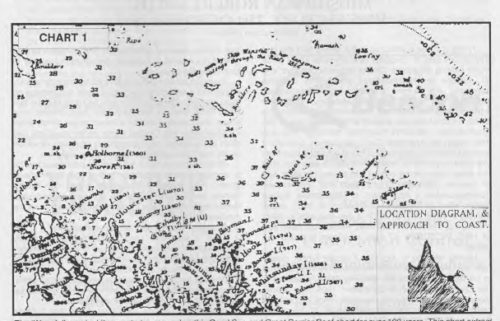- Author
- Nicholson, Ian
- Subjects
- Ship histories and stories, History - pre-Federation
- Tags
-
- RAN Ships
- None noted.
- Publication
- September 1997 edition of the Naval Historical Review (all rights reserved)
For well over a century, until 1977, mariners were intrigued by a warning printed on Admiralty chart BA 2763, amid countless reefs of the outer Barrier Reef, reading:
Reefs seen by Ship `Wansfell’ in her dangerous passage through the Reefs 1864 (chart 1).

There were two further Wansfell reports in the Coral Sea, 110′ and 135′ to the east.
As a junior officer these certainly fascinated me but I was unable to discover the story behind the notes on the chart. The relevant Australia Pilot or Sailing Directions gave only brief details on two Wansfell Reefs, as part of Marion Reef, without any background information. The hydrographic historian Geoffrey Ingleton in his authoritative book Charting a Continent remarks on this well known chart notation but regrets that he was unable to trace any details of the Wansfell’s voyage.
It was left to conjecture; surely the ship was outward bound and keen to get through the Barrier Reef into the open sea, as Captains Cook and Flinders had done in earlier times. In the shallow and sheltered waters inside the Barrier Wansfell could have anchored if need be until the wind was favourable and used her boats to find a suitable exit. Thus she would have been able to proceed through uncharted seas in comparative safety and live to report those numerous reefs. The true story turned out to be quite the opposite.
Keeping an eye out for Wansfell
After retirement from the RAN, in my search for logbooks generally for the Log of Logs series, I kept an eye out for the Wansfell’s log, and narratives of other voyages of interest in the Great Barrier Reef area and Torres Strait, with a view to compiling a maritime history of this famous shipping route. With the aid of the RN and RAN Hydrographic Offices and other institutions I found quite a few relevant old logbooks and reports, though not those of the Wansfell. The book Via Torres Strait eventuated, and from various sources I managed to include in it at least an outline of the saga. The RN Sailing Directions, Vol. 2, of 1879 revealed that Captain Hugh Brodie, inward bound for Port Denison (Bowen) reported the string of uncharted and unnamed reefs to the Admiralty, giving their approximate positions. That at least explained the Wansfell Reefs and Brodie Cay on modern charts, as part of the Marion Reef. The latter name was bestowed by the RN Hydrographer with little logic or precedence for the original discoverer, as Captain Paget, Master of the schooner Marion, did not ‘find’ the feature until five years after the Wansfell.
The second reef seen by Capt. Brodie as he steered for the coast was 75 miles SW of his first report and appeared to be a single detached reef not far from the unbroken line of Barrier breakers, in lat. 20°12’S. The Hydrographer retained the sighting on the chart although marked “(probably a part of the Barrier Reef)”, and it was eventually deleted for that reason. The position of this reef indicates that the ship then skirted NW along some 90 miles of breakers of the outer Barrier before finding a gap. This Wansfell passed through and the third report was the long string of reefs she then met when stumbling through the labyrinth in approx. latitude 19°23’S. (charts 1 and 2). Unfortunately Captain Brodie’s original report could not be located in the archives of the Hydrographic Office at Taunton, nor is there any explanation why and how he had managed to get through the Barrier in an uncharted area where there was no known passage. Furthermore it was in the NW monsoon which was the ‘off-season’ for sailing ships in the Coral Sea, and also the dangerous cyclone season. It must have been a case of fortune favouring the brave.




